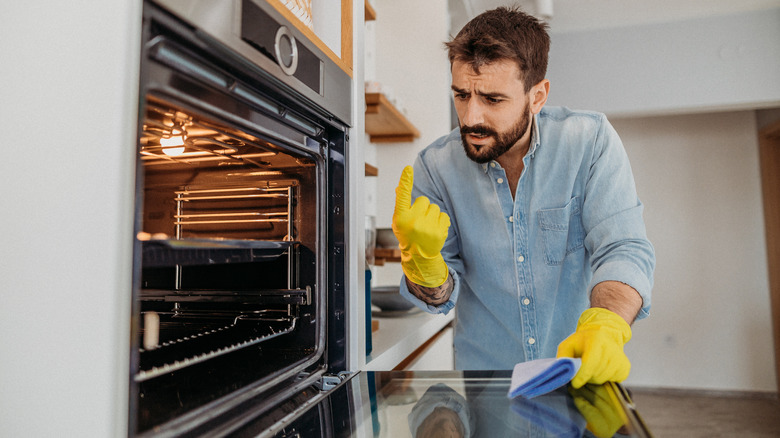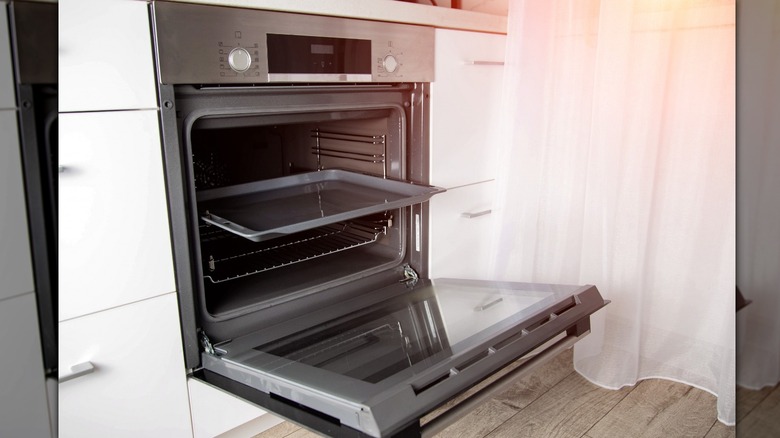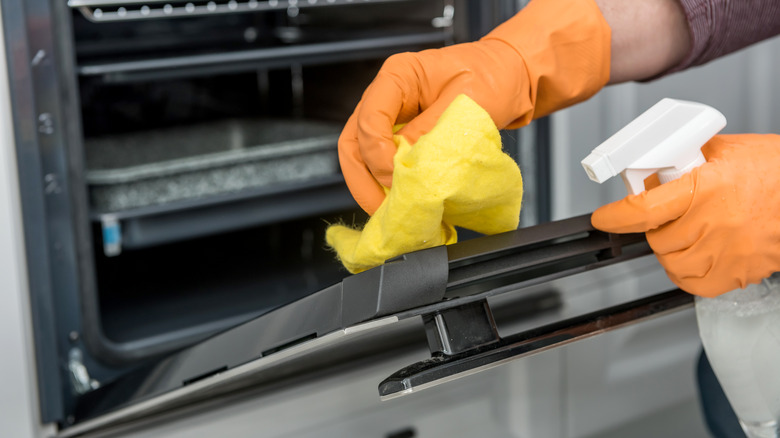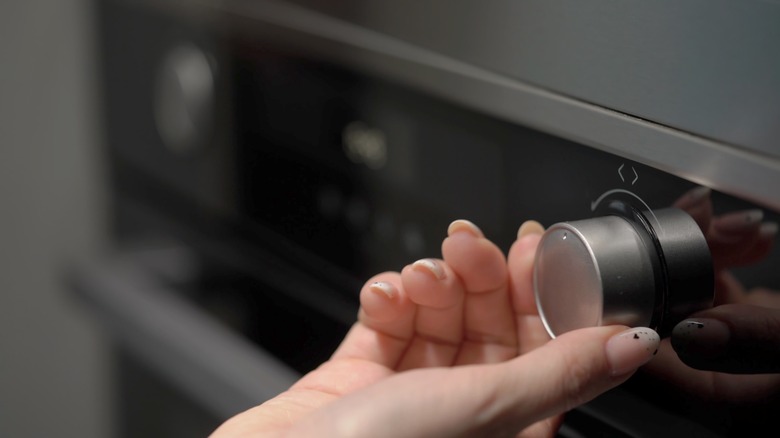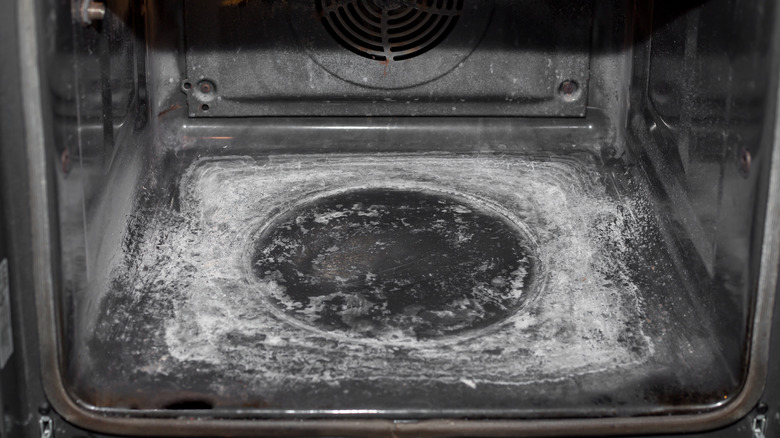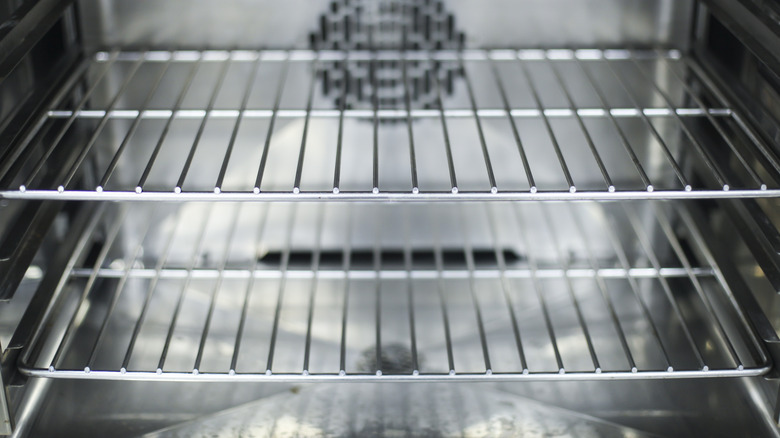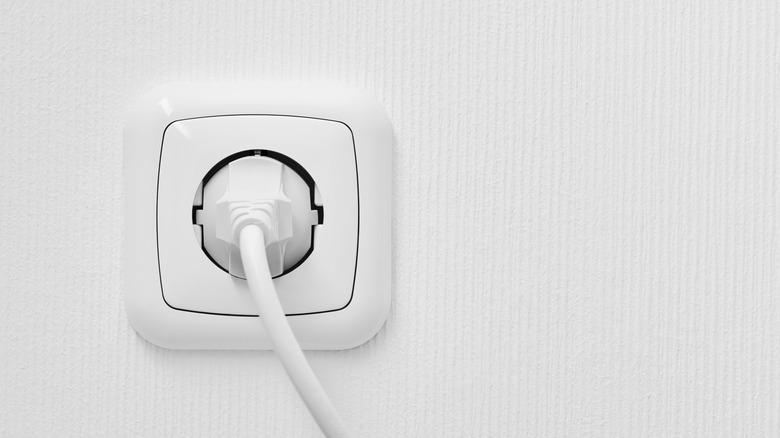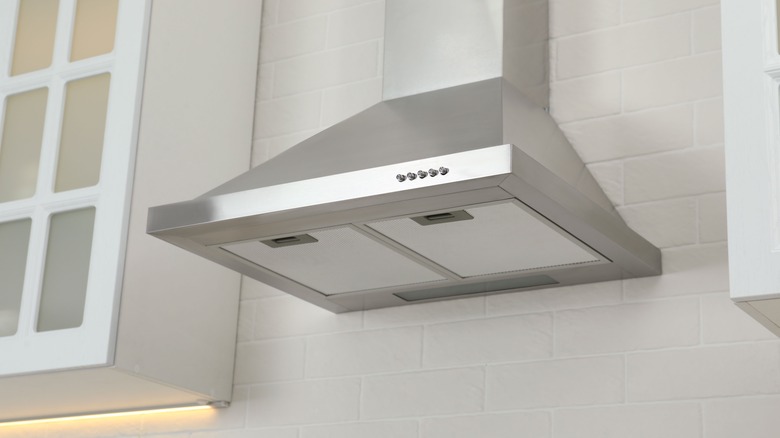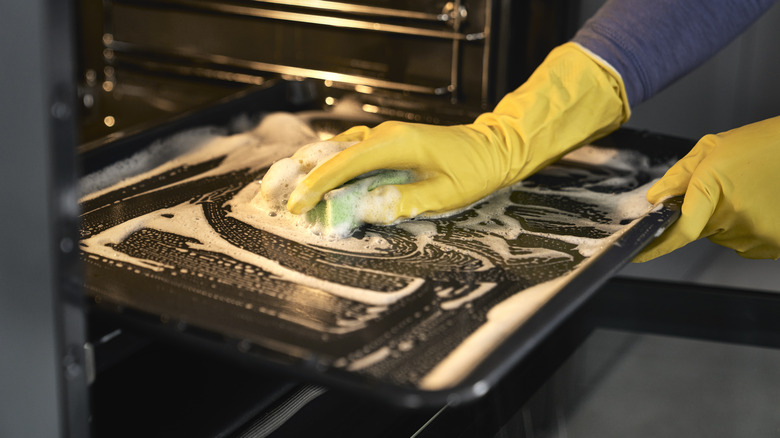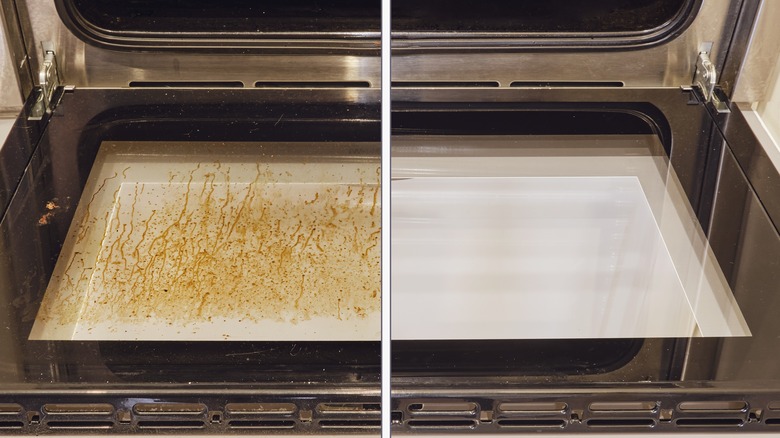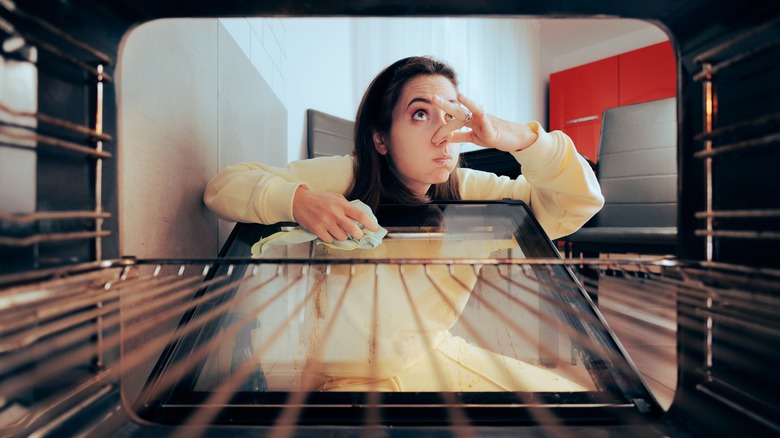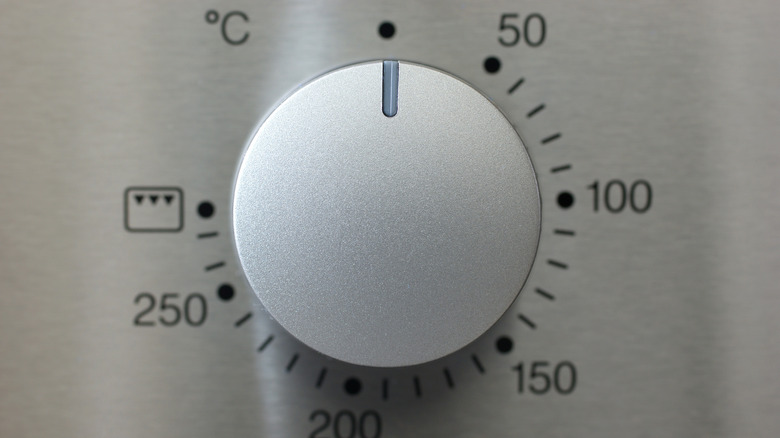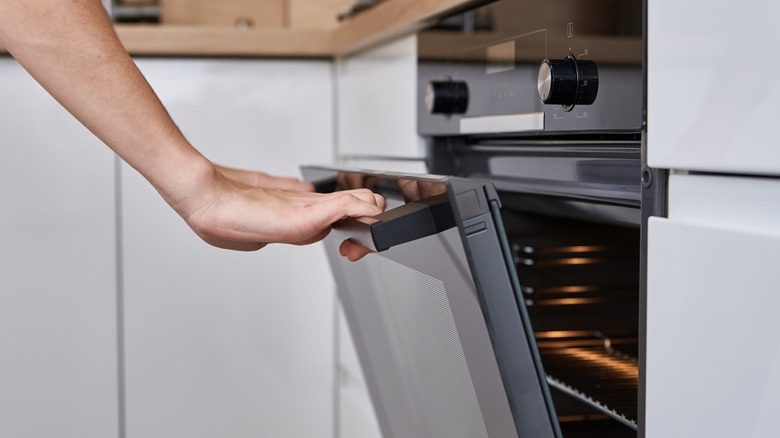13 Oven Cleaning Mistakes You Need To Avoid
It's hard to imagine life without the humble oven. That's partly because it's a piece of kitchen equipment that's been around, in various forms, for millennia. The practice of cooking food in a contained, heated vessel has been performed for almost 30,000 years, with the very first oven-like constructions found by archeologists dating back to 29,000 B.C., in which prehistoric humans would cook portions of roasted woolly mammoth. As time passed, ovens became more advanced, constructed in ancient Greece to bake all manner of foods. And as building and cooking knowledge increased over the years, so did the quality of ovens and the way in which they are cleaned.
Given their ever-present nature in our kitchens, you'd think that we'd have nailed cleaning them by now. But for many, doing so is still somewhat of a mystery, and is an activity that's only performed every now and again. Not cleaning your oven properly, however, can reduce its lifespan (which generally lasts around 13 to 15 years). And when you remember that a new oven can sometimes cost thousands of dollars, taking the time to avoid some key cleaning mistakes is a worthwhile investment.
1. Forgetting to clean a new oven
If your oven's just come out of the box, it's easy to think that it's ready to use, but before you do so, you'll need to clean it. New ovens can often produce an acrid, burning smell when you first turn them on. This can be caused by several factors, all of which are associated with the oven's manufacturing process. Oven construction involves a few materials and chemicals that, when exposed to high heat for the first time, can scorch and burn off, resulting in a pretty strong smell. The burning scent can also be caused by the oven's internal walls receiving their first blast of heat.
Cleaning the inside of your oven before you use may not get rid of the smells entirely, but it will likely reduce them. The best method is to use a large sponge and a solution of soap and water to wash down the interior. Use unscented soap if possible, so you don't inadvertently contribute to any additional smells. Make sure you wash your oven racks as well as the walls and door of the oven. Placing a bowl with a solution of water and lemon juice in your oven, and allowing it to steam, can also reduce strong smells, thanks to lemon's ability to clear odors.
2. Using chemical cleaning solutions
Your oven can be one of the hardest things to clean in the kitchen, thanks to the level of food spills and grime that can build up; however, using harsh cleaning chemicals to tackle these, while tempting, is not the answer. Commercial oven cleaning products can often contain irritants and harmful substances like sodium hydroxide and butoxydiglycol. These substances can be incredibly dangerous, both if they come into contact with your skin or simply if you're breathing in their fumes. Sodium hydroxide, also known as lye, is a corrosive substance and may cause burns and permanent damage if it touches your skin or eyes or if it's ingested, per the Tennessee Department of Health. Butoxydiglycol, similarly, can cause eye and skin damage and may affect your central nervous system (via A Cleaning Service).
You can avoid these risks, however, by opting for natural cleaning solutions. One of the simplest, cheapest combos you can use is vinegar and baking soda. First, make a simple paste of baking soda and water and spread it over all the surfaces in your oven, leaving it for a few hours. Then, spray it all with a solution of water and vinegar. "The acid in the vinegar will react with the baking soda, causing it to foam. This action helps to remove the burnt-on food stains from the oven," explains Neat Services' Sean Parry via Real Simple.
3. Not preheating your oven
Trying to clean your oven when it's cold might be trickier than you think. If your oven has been sitting dormant for a while, the baked-in grime inside will remain hard and immovable. By preheating your oven before you clean it, the higher temperature will loosen the dirt lodged inside and make it more receptive to cleaning materials.
The reason this occurs is that when your oven heats and then cools down, the water vapor in the air inside turns to condensation. This condensation then permeates and softens any dirt in the oven, which then makes it easier to shift. You should preheat your oven long enough for the machine to heat through fully. Additionally, give it enough time to cool down after you've preheated it, to make sure that you're not burning yourself inadvertently when you come to clean it. This may take a bit longer than you think. If you're keeping your oven door shut (which we recommend you do, to allow the maximum amount of condensation to develop, and to ensure that none of it escapes), it might take a few hours before it's fully cool. Opening the door will allow the heat to fade faster if you're in a rush, but it may also reduce the condensation's effect.
4. Neglecting your self-clean function
While you might think that you're alone in your oven-cleaning adventures, your machine may actually be trying to help you. Many ovens come equipped with a self-clean function, which can make cleaning it significantly easier. Contrary to popular belief, however, self-cleaning ovens don't cause your oven to fully clean — rather, they make cleaning them easier. The self-cleaning setting will release a blast of steam or ultra-high heat with the intention of loosening up any baked-in food or dirt. Then, you simply have to wipe away the remains.
Steam-assisted, self-cleaning functions might require you to add water to your oven before you activate them. Bear in mind, however, that self-cleaning cycles come with their own risks and considerations. If you have any debris or leftover food detritus in your oven, the high heat that self-cleaning ovens produce might cause them to incinerate, leading to some unpleasant smells. Additionally, over-using the self-clean function can put a lot of strain on your machine, potentially deteriorating its lifespan or short-circuiting fuses. To avoid this, make sure you're only using self-cleaning cycles whenever your oven is at its most dirty, and the rest of the time, just clean it normally.
5. Forgetting your oven racks
While your oven walls might get the most attention during cleaning, don't forget about the racks. Oven racks can get just as dirty as the other parts and are prone to becoming covered in flecks of burnt-on food. This can not only ruin their appearance but cause baking sheets and other utensils to catch and scrape. Despite this, oven racks are often avoided during an oven clean, quite simply because they're an unwieldy shape, and can be difficult to fit into a sink to scrub properly.
However, one simple solution is to clean them in your bathtub. Remove your oven racks, and place them in a tub full of hot water, ideally lined with old towels to avoid any damage, says cleaning company Neat Services' own Sean Parry, per Real Simple. Then, toss a dishwasher tablet in. Dishwasher tablets are highly effective at removing food dirt and will help to loosen any grime that's become stuck to the racks. "After soaking, use the old toothbrush (or a heavy-duty scrubber) to remove any stuck-on food," Parry explains. Rinse, drain, and dry your racks, and they're ready to be placed back into your oven.
6. Keeping it switched on
Whether your oven is powered by gas or electricity, or uses a fan to distribute heat, it'll be connected to the mains power somewhere, and turning it off is a crucial step before cleaning it. Turning an oven off at its power source gives you the assurance that it won't start operating mid-way through your cleaning and reduces the risk of any electric shocks. Remember, you'll be using liquids to clean your oven and while the interior is generally one solid, sealed shell, there's always the chance that a splash here or there could come into contact with live power. This is especially true if you're also cleaning your oven's control panel, as water could potentially work its way through any gaps in its display.
If you're cleaning an electric oven, it's as simple as turning it off at the wall. Gas ovens, however, may also benefit from the gas being switched off; you may wish to turn it off at the gas shutoff valve, for full peace of mind. Individual gas oven manufacturers may also place valves on their machines: Check the manufacturer's instructions to find where it is for your specific oven.
7. Avoiding your range hood
Many ovens come equipped with a range hood, which provides a vital function when it comes to filtering out food waste. As your food cooks and releases steam, grease, or smoke, the range hood helps to suck it away, keeping the air in your kitchen clean. Range hoods can also often come embedded with lights, allowing you to actually see your food while you're cooking it.
But range hoods have a knack for getting dirtier than you think. Grease can build up from repeated cooking sessions, potentially diminishing their quality. The filters of a range hood are likely to get the dirtiest, so keeping them clean is vital. Removing them and soaking them in a warm solution of soap and water can help to get them clean, and you may need to employ heavier-duty methods, too.
"If grease deposits are really caked on you can soak your filters in boiling hot water with dish soap and baking soda overnight to help loosen the gunk build-up. Some filters/baffles are dishwasher-safe so you can just pop them in the dishwasher," states Abt Electronics appliance expert Shirley Hood in an interview with Homes and Gardens. Grease can also build up on the outside of a range hood, not only looking unsightly but making your kitchen smell unpleasant. Again, use a soap-and-water solution, or an environmently-friendly metal cleaner.
8. Trying to clean too quickly
While no one wants to spend their full day cleaning their oven, it might take a bit longer than you think. As they're heated repeatedly, ovens have a nasty habit of making the dirt inside harder and more baked-in with each use. This makes cleaning that dirt much more difficult, and any cleaner you're using will need time to permeate the grime and soften it sufficiently so you can get rid of it.
How long you need to wait depends on the cleaner you're using. If you're using a baking soda and water solution, you'll need to give it at least 20 minutes to operate on the dirt. This will give the soda enough time to break down the molecules of the dirt and soften it, making it easier to wipe away. If you have time to leave it longer, though, it's recommended, as the longer you allow it to cut through, the more effective it'll be. Vinegar might need slightly longer. Give the solution at least an hour to work through the grime before cleaning it away with a sponge soaked in a soap and water solution.
9. Forgetting about the door
Your oven's door is arguably the most visible part of the whole machine, and it's the aspect that also has one of the most important functions. It not only quite literally operates as a portal to the oven inside, but its see-through glass allows you to see your food as it cooks, allowing you to monitor its progress without having to open it up, thus lowering the temperature.
But given their transparent nature, oven doors show dirt far quicker than other parts of the machine, and they can quickly make your oven look pretty ugly. It's best to clean the inside of your oven door with a natural cleaning product, like baking soda, leaving it to soak as you would in the rest of your oven. Cleaning self-hide oven doors, which disappear into a slot underneath the oven when you open them, can be tricky, as you require the door to be static while the baking soda works. In these instances, you may need to remove the oven door entirely, following the manufacturer's instructions to do so.
Cleaning the outside of an oven door will likely be less time-consuming than the inside, as less dirt will have had a chance to accumulate. You can use a glass cleaner to do this but bear in mind that the outside of an oven door can get very hot, so use a natural one that won't release fumes when heated.
10. Leaving it too long before you clean
Cleaning an oven is, understandably, not the most exciting job in the world. But you shouldn't put it off. The longer you leave your oven between cleaning sessions, the more opportunity you'll give it to build up layers of dirt. And this has more of an impact than just looking bad.
"Having excess residue built up in your oven will not only make your food taste unpleasant, but will also make your oven work harder to cook or bake your food to the ideal temperature," says Mr. Appliance president Ron Shimek in an interview with Martha Stewart. This can have a knock-on effect on the overall health of your oven, and in the worst-case scenarios, be hazardous and increase fire risk.
Ideally, you should clean your oven every three months at a minimum. The three-month point is a good benchmark to work from, as it's enough time to justify all the elbow grease it takes. If your oven is used frequently it might need to be cleaned more often. It's also important to remember that just because you should do a deep clean every few months, that doesn't mean you shouldn't be cleaning up any spills or food as you go.
11. Cleaning at the wrong time
Tackling your dirty oven is as much about when you choose to clean it, as how you choose to clean it. Cleaning an oven can be a lengthy job, and the products you use will take time to work into the dirt and shift it properly. Furthermore, once you've fully finished cleaning, you'll need to give any excess water enough time to evaporate. This all may prove problematic if you're trying to clean your oven too soon before wanting to use it to make food.
It's advised that you give yourself a two or three-hour window after cleaning your oven before you need to use it, to ensure you have ample time to get rid of all the dirt. If you're using a store-bought cleaner, make sure you're giving it the time it dictates on the packaging, otherwise, it won't be able to operate effectively. Bear in mind, too, that some cleaning methods may take longer than others. If you're operating a self-cleaning cycle, you will need a lengthy amount of time, as the oven will take a while to come back down to a safe temperature.
12. Not cleaning your knobs
Oven knobs may not be the most glamorous thing to clean, but they sure are important to tackle. They are likely the part of the oven that you touch the most, and that means that they have a knack for getting covered in greasy fingerprints. Additionally, if your oven has a stove on top of it, the knobs can easily get covered in food splatter. When that splatter starts to work its way into the gaps between the knobs and the oven's body, it can become more difficult to get things totally sparkling.
While oven knobs can be tricky to clean, if they're detachable, they may take less work than you think. Detachable oven knobs are often dishwasher-friendly and can be put in your regular cycle alongside your plates and cutlery. Cleaning them in the dishwasher is especially effective as dishwashers are designed to tackle hard-to-reach dirt that gets lodged inside cups and forks. If you don't have a dishwasher, you can also clean them by soaking them in a warm mixture of soap and water until any dirt loosens up, and then wiping them clean with a soft cloth. Additionally, you can use a toothbrush to get into any hard-to-clean gaps.
13. Forgetting to clean behind your oven
Ovens, particularly those with stoves, have an uncanny habit of getting food everywhere but inside the oven itself. And it's very easy for food to end up behind your oven through spillage. Food falling behind the oven can be problematic as it can draw mice into your kitchen, creating a rodent problem. A build-up of dropped food can also create cleaning issues or may produce unwanted smells in your kitchen.
While cleaning behind the oven isn't an everyday job, you should aim to do it once every six months or so, or more often if you know food has been disappearing behind there frequently. Some ovens come equipped with warming drawers at their base, which you can remove to gain quick access to the back. Once you've done this, you can then vacuum everything up using the long handle attachment on your vacuum cleaner. If your oven doesn't have a warming drawer, you may need to pull or roll it out to clean behind it. Just make sure you get someone to help you do this; ovens can be incredibly heavy, and you don't want to injure yourself.
